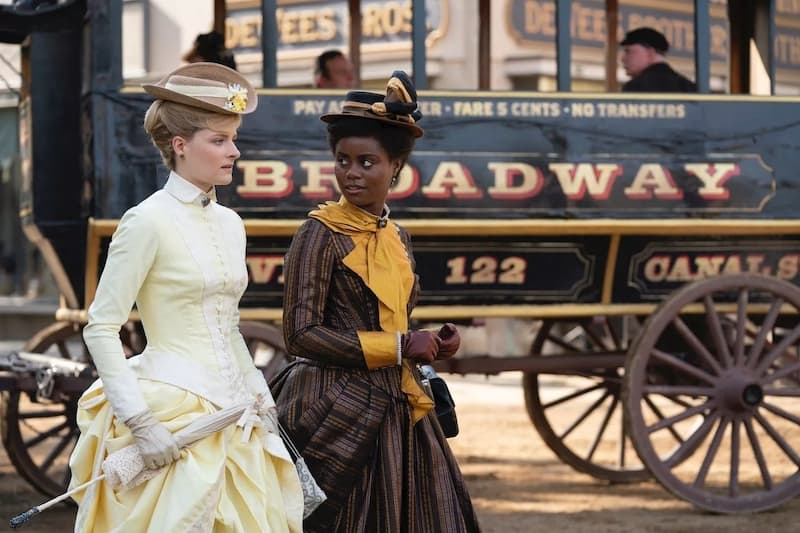Every few months, someone on Twitter or Instagram takes it upon themselves to compose a set of rules. What to post, and how often. How to interact, and with whom. These posts are often roundly rejected, but it’s clear nonetheless that the internet does have its own intricate rules of engagement. The Gilded Age, HBO’s new show by Downton Abbey creator Julian Fellowes, is a story built around the influencers of the late 1800s and the intricate social rules that bound them. The high society figures may not compare follower counts, but they do compare dinner guests. They technically can’t subtweet one another, but their coded verbal jousts always hit their intended target.
The series begins when young Marian (Louisa Jacobson) is uprooted from her simple life and thrust into the middle of this organized madness. When her father dies, she finds herself destitute, and she moves in with her two aunts, widowed Agnes (Christine Baranski) and spinster Ada (Cynthia Nixon). Marian is earnest and plucky, and tradition-bound Agnes works hard to curb her more outspoken tendencies from their very first meeting.
Agnes, the show’s funniest and most enjoyably frustrating character, holds her outdated convictions with certainty. She thinks it’s unbecoming for Marian to wear black, carry her own suitcase, hold a job, or even go outside alone. When she sees someone she doesn’t like at a charity event, she quips, “Why don’t we just go outside and roam in the gutter? It will save time.” Baranski plays Agnes perfectly. And sweet, simple Ada is her perfect counterpart. They’re like Hilda and Zelda from The Chilling Adventures of Sabrina, or Vivian and Lily from Pushing Daisies, except that Agnes’ stern adherence to worn-out traditions seems untenable in the long run.
This trio makes up only a fraction of a widely sprawling cast of characters, all of whom live near the upscale neighborhood of New York City’s 61st Street. The Gilded Age spreads its time between 12 main cast members, though there are at least two dozen we’re meant to keep straight. The series could do with some paring down but is surprisingly riveting despite being overstuffed. In the five episodes available for review, several standouts have emerged, including savage new money power couple Bertha and George Russell (Carrie Coon and Morgan Spector), Agnes’ sardonic son Oscar (Blake Ritson), and Peggy (Denée Benton) a Black writer who becomes fast friends with Marian.
The Gilded Age works with familiar archetypes but polishes them into an enrapturing shine nonetheless. Fans of Downton Abbey will see the DNA of several key characters in this new ensemble, but the characters also call to mind classic literary figures. The series draws most deeply and obviously from the works of Edith Wharton, but its observations about wealth often call to mind Charles Dickens as well. When one character says that money isn’t everything, Marian shoots back, “It is when you haven’t got it!”
Marian, herself, might be the show’s most puzzling character. Devoid of much context about what has informed her near-perfect personality, the egalitarian go-getter character is a hair’s breadth away from being a bona fide Mary Sue. Yet Marian is always just slightly more complex than expected, as when she shows a special brand of cheerful ignorance towards Peggy that accidentally veers into racism more than once. Aside from the rare missteps that remind us that she’s human, Marian is like a Louisa May Alcott character living in a Real Housewives of Fifth Avenue world.
Don’t let my modern comparisons mislead you; The Gilded Age is a period piece through and through. Luxe sets are populated by characters wearing deliciously stylish custom outfits, and both aspects are among the series’ biggest draws. In one scene, each characters’ status — or at least their cockiness — is revealed entirely through the outlandishly large and intricate hats they wear. No one on screen comments on the hat war, but it’s obvious, and there’s a clear winner, too. And no one wears the 1880s better than Carrie Coon’s Bertha Russell, the series’ most captivating character.
Coon’s talents are wide-ranging and well-proven, but it’s still a special treat to see her dig into a character like Mrs. Russell. As the stylish wife of a robber baron who rose quickly through the ranks of society, she’s confident and openly cutthroat. The more the women of her insular neighborhood shun her, the more she pushes at the edges of the status quo. Her most pertinent offense in the eyes of her peers seems to be hiring a different architect than the rest of them, but she commits one creative show of power after another simply to make them stand at attention. Coon is dazzling in the role of a constant striver whose ambition knows no bounds, and in an enjoyable surprise, her equally money-minded husband loves her for it. When he tells her she’s come a long way, she says, “I don’t want to come a long way. I want to go all the way.”
The Gilded Age has enough enjoyable bits and bobs to keep almost anyone interested, but even the most period piece avoidant will be drawn to Carrie Coon’s magnetic performance. Come for the style and intrigue, stay to see Mrs. Russell grab up as many Monopoly pieces as she can, then dance all over the game board.

